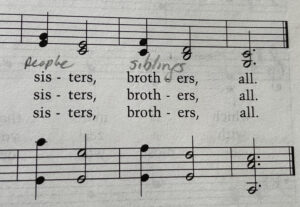“He (sic) drew a circle that shut me out- heretic, rebel, a thing to flout. But love and I had the wit to win: We drew a circle and took him In!”
On Sunday, I preached about all the theological and linguistic changes that Unitarians and Universalists have made over the centuries. I suggested that one way to invite folks to try out Unitarian Universalism when they are suspicious of religion is to share a few facts like these:
- 50 years ago we tossed out male-only language to include women and feminine images for the divine.
- 150 years ago we explicitly embraced Religious Humanists in our language.
- 175 years ago we started focusing on the wonder and beauty of nature as an expression/description of the divine.
- 180 years ago we dropped the language of “sinners” and “saints” (as well as the word “Christ”.)
- 240 years ago (and longer ago than that) we started messing with “traditional” words… and we haven’t stopped.

I shared the story that the 1964 hymnal was almost immediately obsolete because it did not include gender inclusive language, and that some congregations edited hymnals on their own, crossing out words and writing new ones in the margins. As we were singing our final hymn, I realized that I’d forgotten to invite folks to change some of the words from a gender binary (“sisters, brothers”) to non-binary language in order to include everyone. I shouted out suggestions while we were singing, but I’m sure they were hard to hear. Then, after the service, Bob Watts showed me that in the hymnal he was using, someone had already written in the words “people, siblings”. The tradition continues!
Another update: Two weeks ago when I preached on the spiritual practice of generosity, I mentioned that women are still paid on average 82 cents to the dollar compared to men. One of you informed me that this is only true for white women; Black women earn on average just 64 cents for every dollar a white man earned in 2022. That’s a harsh reminder about “intersectionality”.
Yours, learning right alongside y’all,
Rev. Lee
P.S. If you are curious about non-patriarchal versions of “The Lord’s Prayer”, one website with a collection is by seminary professor Mary Hess here. This list includes the Aramaic version suggested by Neil Douglas-Klotz in his book Prayers of the Cosmos. Aramaic is the language Jesus would have spoken most; he spent most of his time in the Aramaic-speaking villages of Nazareth and Capernaum in Galilee. But Hebrew and Greek were also spoken at the time; the Bible was translated into Greek (with some doozie mis-translations!)
P.P.S. I’d love it if we could collect YOUR images of the embodiment of the “divine” and create a mini slide show! Whether the Tara at Wonderwell Mountain Shrine, goddesses you’ve acquired, images of the interdependent web, Hindu gods or goddesses, non-white Jesuses- what images do you have in your homes? Send along to RevLee@northparish.org
